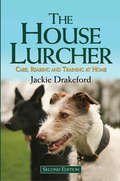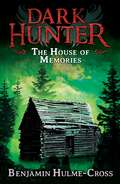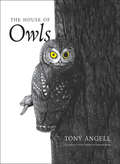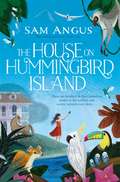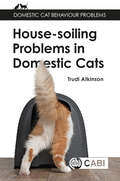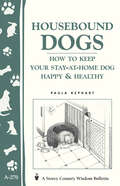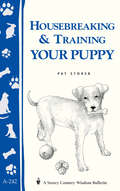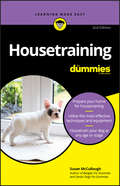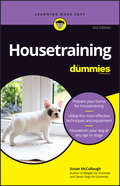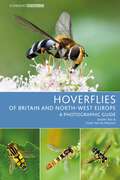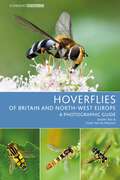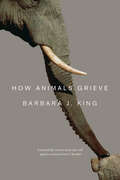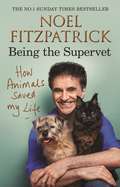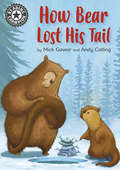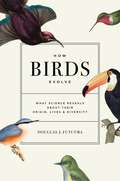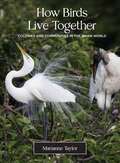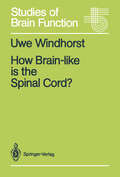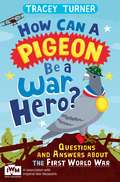- Table View
- List View
House Lurcher: Care, Rearing and Training at Home
by Jackie DrakefordAs result of many training enquiries over the years Jackie Drakeford wrote The House Lurcher for owners of pet lurchers and domestic greyhounds. Through the book, the reader learns how to live happily with their lurcher at home and in public. In particular, they will learn how to establish a sound recall so that their lurcher can be exercised with confidence off the lead. All aspects of owning and training lurchers are covered in detail. Now fully updated the book takes into account recent changes to the law as it relates to hunting with dogs.
House of Memories (Dark Hunter)
by Benjamin Hulme-CrossA six-book series of supernatural horror scares that will hook even the most reluctant readers. The Dark Hunter Mr Blood and his young assistants Edgar and Mary take on a series of terrifying mysteries, dealing with ghosts, vampires, werewolves and even weirder threats. In this tale, Mary and Edgar must confront a demonic terror from their forgotten childhood.Highly readable, exciting books that take the struggle out of reading, Dark Hunter encourages and supports reading practice by providing gripping, age-appropriate stories for struggling and reluctant readers or those with English as an additional language aged 11+, at a manageable length (64 pages) and reading level (7+). Produced in association with reading experts at CatchUp, a charity which aims to address underachievement caused by literacy and numeracy difficulties.Book band: Lime
The House of Owls
by Mr. Tony AngellFor a quarter of a century, Tony Angell and his family shared the remarkable experience of closely observing pairs of western screech owls that occupied a nesting box outside the window of their forest home. The journals in which the author recorded his observations, and the captivating drawings he created, form the heart of this compelling book—a personal account of an artist-naturalist’s life with owls. Angell’s extensive illustrations show owls engaged in what owls do—hunting, courting, raising families, and exercising their inquisitive natures—and reveal his immeasurable respect for their secret lives and daunting challenges. Angell discusses the unique characteristics that distinguish owls from other bird species and provides a fascinating overview of the impact owls have had on human culture and thought. He also offers detailed scientific descriptions of the nineteen species of owls found in North America, as well as their close relatives elsewhere. Always emphasizing the interaction of humans and owls, the author affirms by his own example the power of these birds both to beguile and to inspire.
The House on Hummingbird Island
by Sam Angus'We're going to a fine place,' Idie told Homer to console him, 'with gullies and monkeys and hummingbirds.' Idie Grace is twelve when she inherits a grand old house on a Caribbean island, and is sent away from grey old England to a place where hummingbirds hover and monkeys clamber from tree to tree.As a lady of property Idie can do as she pleases, so she fills the house with exotic animals, keeps her beloved horse in the hallway, and carries a grumpy, talking cockatoo called Homer on her shoulder. But the island house holds as many secrets as it does animals, and the truth behind Idie's inheritance is the biggest secret of all . . .Perfect for fans of Eva Ibbotson and Katherine Rundell
House-soiling Problems in Domestic Cats (Domestic Cat Behaviour Problems)
by Trudi AtkinsonHighly practical, this book is the first in a series entitled Domestic Cat Behaviour Problems designed to help veterinary professionals and behaviourists understand the background behind common domestic cat behaviour problems and provide various treatment strategies. The text in this volume covers feline problem elimination and marking behaviour inside the home, outlining: *Normal behaviour. *The various underlying causes of feline house-soiling. *Prevention of unwanted behaviour. *Recognition of potential trigger factors and warning signs. *How to identify contributory factors. *Practical treatment strategies. Brimming with sound practical advice, this book will be invaluable to veterinarians, veterinary nurses/technicians, clinical animal behaviourists, and those studying domestic cat behaviour.
Housebound Dogs: (Storey's Country Wisdom Bulletin A-270) (Storey Country Wisdom Bulletin)
by Paula KephartDog-Proof Your Home and House-Proof Your Dog!Does leaving your dog home alone result in broken lamps, chewed shoes, and warm puddles on the floor? Or does the thought of your forlorn pup waiting sadly at the door make you want to turn the car around? Help is here.Stay-at-home dogs are a reality in today's busy world. But with proper training, a dog left home alone is neither lonely nor destructive. In Housebound Dogs, Paula Kephart helps you understand the natural tendencies and insecurities of a housebound dog on its own. With her expert advice and simple training techniques, you can make your home a safe, comfortable, and cheery haven for your canine companion, and your dog will learn to be trustworthy and responsible in the house.
Housebreaking & Training Your Puppy: Storey's Country Wisdom Bulletin A-242 (Storey Country Wisdom Bulletin)
by Pat StorerHappy Puppies, Proud Owners!Puppies are great fun, and they make wonderful family pets. However, puppies can also be a lot of work - they're playful to the point of being rambunctious, they tend to make a mess of the house, and they demand a lot of attention. How do you help your playful, energetic puppy become a happy, well-mannered member of the family? It's all in the training!Pat Storer offers expert advice on housebreaking a new puppy and teaching basic obedience. Her tried-and-true approach -- emphasizing firmness, consistency, and patience -- is guaranteed to help owners earn their puppies' respect, trust, and confidence. Storer also offers tips and tricks for solving common behavior problems.
Housetraining For Dummies
by Susan McCulloughHousetraining For Dummies (9781119610298) was previously published as Housetraining For Dummies (9780470476376). While this version features a new Dummies cover and design, the content is the same as the prior release and should not be considered a new or updated product. The latest information and tips on making housetraining easier for your pet and yourself Did you know that what you feed your dog can effect help or hinder the housetraining process? That's just one of the valuable tips you'll find in Housetraining For Dummies 2nd Edition, the authoritative housetraining reference for new and veteran pet owners alike. This new edition features plenty of new and revised material on everything from the latest housetraining equipment to the latest information on diet and nutrition and the crucial role it plays in housetraining. You'll also find useful tips and techniques for creating environmentally safe cleaners from natural products found in the home and alternatives you can use if you have a sensitive pet. Features the latest findings on how pet nutrition can influence housetraining success Offers proven housetraining strategies Introduces new methods for housetraining multiple pets at once Reviews new housetraining equipment and products Shows you how to make environmentally safe stain and odor removers from products already in your home Susan McCullough is a columnist for Dog Fancy magazine and the author of several books including Beagles For Dummies ;and the award-winning Senior Dogs For Dummies Housetraining can be a difficult and stressful process for both you and your puppy, adult, or senior dog. Housetraining For Dummies 2nd Edition is the resource you need to make it faster and easier for both of you.
Housetraining For Dummies
by Susan McCulloughHousetraining For Dummies (9781119610298) was previously published as Housetraining For Dummies (9780470476376). While this version features a new Dummies cover and design, the content is the same as the prior release and should not be considered a new or updated product. The latest information and tips on making housetraining easier for your pet and yourself Did you know that what you feed your dog can effect help or hinder the housetraining process? That's just one of the valuable tips you'll find in Housetraining For Dummies 2nd Edition, the authoritative housetraining reference for new and veteran pet owners alike. This new edition features plenty of new and revised material on everything from the latest housetraining equipment to the latest information on diet and nutrition and the crucial role it plays in housetraining. You'll also find useful tips and techniques for creating environmentally safe cleaners from natural products found in the home and alternatives you can use if you have a sensitive pet. Features the latest findings on how pet nutrition can influence housetraining success Offers proven housetraining strategies Introduces new methods for housetraining multiple pets at once Reviews new housetraining equipment and products Shows you how to make environmentally safe stain and odor removers from products already in your home Susan McCullough is a columnist for Dog Fancy magazine and the author of several books including Beagles For Dummies ;and the award-winning Senior Dogs For Dummies Housetraining can be a difficult and stressful process for both you and your puppy, adult, or senior dog. Housetraining For Dummies 2nd Edition is the resource you need to make it faster and easier for both of you.
Hoverflies of Britain and North-west Europe: A photographic guide (Bloomsbury Naturalist)
by Sander Bot Frank Van MeutterThe most complete photographic field guide to hoverflies of Britain and North-west Europe ever written.An essential part of our eco-systems, hoverflies are the second most important pollinators after bees but sadly, more than a third of all European species are now under threat of extinction. Written by two leading experts, Hoverflies of Britain and North-west Europe is the first and only photographic field guide to cover all 400 hoverfly species occurring in Britain and neighbouring countries in such detail.Each species account contains a description, population status, ecology and habitat, an up-to-date map of its distribution across North-western Europe, a flight time diagram and guidance on differentiating similar species. There are also detailed illustrations and stunning full-colour macro photographs in each account, showing key features of the species to aid accurate identification.This is the ultimate photographic field guide to hoverflies, and a perfect introduction into the world of these important pollinators, both for amateur and expert entomologists alike.
Hoverflies of Britain and North-west Europe: A photographic guide (Bloomsbury Naturalist)
by Sander Bot Frank Van MeutterThe most complete photographic field guide to hoverflies of Britain and North-west Europe ever written.An essential part of our eco-systems, hoverflies are the second most important pollinators after bees but sadly, more than a third of all European species are now under threat of extinction. Written by two leading experts, Hoverflies of Britain and North-west Europe is the first and only photographic field guide to cover all 400 hoverfly species occurring in Britain and neighbouring countries in such detail.Each species account contains a description, population status, ecology and habitat, an up-to-date map of its distribution across North-western Europe, a flight time diagram and guidance on differentiating similar species. There are also detailed illustrations and stunning full-colour macro photographs in each account, showing key features of the species to aid accurate identification.This is the ultimate photographic field guide to hoverflies, and a perfect introduction into the world of these important pollinators, both for amateur and expert entomologists alike.
How Animals Grieve
by Barbara J. KingFrom the time of our earliest childhood encounters with animals, we casually ascribe familiar emotions to them. But scientists have long cautioned against such anthropomorphizing, arguing that it limits our ability to truly comprehend the lives of other creatures. Recently, however, things have begun to shift in the other direction, and anthropologist Barbara J. King is at the forefront of that movement, arguing strenuously that we can—and should—attend to animal emotions. With How Animals Grieve, she draws our attention to the specific case of grief, and relates story after story—from fieldsites, farms, homes, and more—of animals mourning lost companions, mates, or friends. King tells of elephants surrounding their matriarch as she weakens and dies, and, in the following days, attending to her corpse as if holding a vigil. A housecat loses her sister, from whom she's never before been parted, and spends weeks pacing the apartment, wailing plaintively. A baboon loses her daughter to a predator and sinks into grief. In each case, King uses her anthropological training to interpret and try to explain what we see—to help us understand this animal grief properly, as something neither the same as nor wholly different from the human experience of loss. The resulting book is both daring and down-to-earth, strikingly ambitious even as it’s careful to acknowledge the limits of our understanding. Through the moving stories she chronicles and analyzes so beautifully, King brings us closer to the animals with whom we share a planet, and helps us see our own experiences, attachments, and emotions as part of a larger web of life, death, love, and loss.
How Animals Grieve
by Barbara J. KingFrom the time of our earliest childhood encounters with animals, we casually ascribe familiar emotions to them. But scientists have long cautioned against such anthropomorphizing, arguing that it limits our ability to truly comprehend the lives of other creatures. Recently, however, things have begun to shift in the other direction, and anthropologist Barbara J. King is at the forefront of that movement, arguing strenuously that we can—and should—attend to animal emotions. With How Animals Grieve, she draws our attention to the specific case of grief, and relates story after story—from fieldsites, farms, homes, and more—of animals mourning lost companions, mates, or friends. King tells of elephants surrounding their matriarch as she weakens and dies, and, in the following days, attending to her corpse as if holding a vigil. A housecat loses her sister, from whom she's never before been parted, and spends weeks pacing the apartment, wailing plaintively. A baboon loses her daughter to a predator and sinks into grief. In each case, King uses her anthropological training to interpret and try to explain what we see—to help us understand this animal grief properly, as something neither the same as nor wholly different from the human experience of loss. The resulting book is both daring and down-to-earth, strikingly ambitious even as it’s careful to acknowledge the limits of our understanding. Through the moving stories she chronicles and analyzes so beautifully, King brings us closer to the animals with whom we share a planet, and helps us see our own experiences, attachments, and emotions as part of a larger web of life, death, love, and loss.
How Animals Grieve
by Barbara J. KingFrom the time of our earliest childhood encounters with animals, we casually ascribe familiar emotions to them. But scientists have long cautioned against such anthropomorphizing, arguing that it limits our ability to truly comprehend the lives of other creatures. Recently, however, things have begun to shift in the other direction, and anthropologist Barbara J. King is at the forefront of that movement, arguing strenuously that we can—and should—attend to animal emotions. With How Animals Grieve, she draws our attention to the specific case of grief, and relates story after story—from fieldsites, farms, homes, and more—of animals mourning lost companions, mates, or friends. King tells of elephants surrounding their matriarch as she weakens and dies, and, in the following days, attending to her corpse as if holding a vigil. A housecat loses her sister, from whom she's never before been parted, and spends weeks pacing the apartment, wailing plaintively. A baboon loses her daughter to a predator and sinks into grief. In each case, King uses her anthropological training to interpret and try to explain what we see—to help us understand this animal grief properly, as something neither the same as nor wholly different from the human experience of loss. The resulting book is both daring and down-to-earth, strikingly ambitious even as it’s careful to acknowledge the limits of our understanding. Through the moving stories she chronicles and analyzes so beautifully, King brings us closer to the animals with whom we share a planet, and helps us see our own experiences, attachments, and emotions as part of a larger web of life, death, love, and loss.
How Animals Grieve
by Barbara J. KingFrom the time of our earliest childhood encounters with animals, we casually ascribe familiar emotions to them. But scientists have long cautioned against such anthropomorphizing, arguing that it limits our ability to truly comprehend the lives of other creatures. Recently, however, things have begun to shift in the other direction, and anthropologist Barbara J. King is at the forefront of that movement, arguing strenuously that we can—and should—attend to animal emotions. With How Animals Grieve, she draws our attention to the specific case of grief, and relates story after story—from fieldsites, farms, homes, and more—of animals mourning lost companions, mates, or friends. King tells of elephants surrounding their matriarch as she weakens and dies, and, in the following days, attending to her corpse as if holding a vigil. A housecat loses her sister, from whom she's never before been parted, and spends weeks pacing the apartment, wailing plaintively. A baboon loses her daughter to a predator and sinks into grief. In each case, King uses her anthropological training to interpret and try to explain what we see—to help us understand this animal grief properly, as something neither the same as nor wholly different from the human experience of loss. The resulting book is both daring and down-to-earth, strikingly ambitious even as it’s careful to acknowledge the limits of our understanding. Through the moving stories she chronicles and analyzes so beautifully, King brings us closer to the animals with whom we share a planet, and helps us see our own experiences, attachments, and emotions as part of a larger web of life, death, love, and loss.
How Animals Grieve
by Barbara J. KingFrom the time of our earliest childhood encounters with animals, we casually ascribe familiar emotions to them. But scientists have long cautioned against such anthropomorphizing, arguing that it limits our ability to truly comprehend the lives of other creatures. Recently, however, things have begun to shift in the other direction, and anthropologist Barbara J. King is at the forefront of that movement, arguing strenuously that we can—and should—attend to animal emotions. With How Animals Grieve, she draws our attention to the specific case of grief, and relates story after story—from fieldsites, farms, homes, and more—of animals mourning lost companions, mates, or friends. King tells of elephants surrounding their matriarch as she weakens and dies, and, in the following days, attending to her corpse as if holding a vigil. A housecat loses her sister, from whom she's never before been parted, and spends weeks pacing the apartment, wailing plaintively. A baboon loses her daughter to a predator and sinks into grief. In each case, King uses her anthropological training to interpret and try to explain what we see—to help us understand this animal grief properly, as something neither the same as nor wholly different from the human experience of loss. The resulting book is both daring and down-to-earth, strikingly ambitious even as it’s careful to acknowledge the limits of our understanding. Through the moving stories she chronicles and analyzes so beautifully, King brings us closer to the animals with whom we share a planet, and helps us see our own experiences, attachments, and emotions as part of a larger web of life, death, love, and loss.
How Animals Grieve
by Barbara J. KingFrom the time of our earliest childhood encounters with animals, we casually ascribe familiar emotions to them. But scientists have long cautioned against such anthropomorphizing, arguing that it limits our ability to truly comprehend the lives of other creatures. Recently, however, things have begun to shift in the other direction, and anthropologist Barbara J. King is at the forefront of that movement, arguing strenuously that we can—and should—attend to animal emotions. With How Animals Grieve, she draws our attention to the specific case of grief, and relates story after story—from fieldsites, farms, homes, and more—of animals mourning lost companions, mates, or friends. King tells of elephants surrounding their matriarch as she weakens and dies, and, in the following days, attending to her corpse as if holding a vigil. A housecat loses her sister, from whom she's never before been parted, and spends weeks pacing the apartment, wailing plaintively. A baboon loses her daughter to a predator and sinks into grief. In each case, King uses her anthropological training to interpret and try to explain what we see—to help us understand this animal grief properly, as something neither the same as nor wholly different from the human experience of loss. The resulting book is both daring and down-to-earth, strikingly ambitious even as it’s careful to acknowledge the limits of our understanding. Through the moving stories she chronicles and analyzes so beautifully, King brings us closer to the animals with whom we share a planet, and helps us see our own experiences, attachments, and emotions as part of a larger web of life, death, love, and loss.
How Animals Saved My Life: Being the Supervet
by Professor Noel FitzpatrickIt has been 30 years since Noel Fitzpatrick graduated as a veterinary surgeon, and that 22-year-old from Ballyfin, Ireland, is now one of the leading veterinary surgeons in the world. The journey to that point has seen Noel treat thousands of animals - many of whom were thought to be beyond help - animals that have changed his life, and the lives of those around them, for the better.If the No.1 Sunday Times bestseller Listening to the Animals was about Noel's path to becoming The Supervet, then How Animals Saved My Life is about what it's like to actually be The Supervet. Noel shares the moving and often funny stories of the animals he's treated and the unique 'animal people' he has met along the way. He reflects on the valuable lessons of Integrity, Care, Love and Hope that they have taught him - lessons that have sustained him through the unbelievable highs and crushing lows of a profession where lives are quite literally at stake.As Noel explores what makes us connect with animals so deeply, we meet Peanut, the world's first cat with two front bionic limbs; eight-year-old therapy dachschund Olive; Odin, a gorgeous five-year-old Dobermann, who would prove to be one of Noel's most challenging cases - and of course his beloved companions Ricochet, the Maine Coon, and Keira, the scruffy Border terrier who is always by his side.
How Bear Lost His Tail: Independent Reading 11 (Reading Champion #3)
by Mick GowarA fun retelling of this Native American legend. Bear is tricked by Otter into fishing with his beautiful, long tail - and it ends up getting frozen and snapping off!Reading Champion offers independent reading books for children to practise and reinforce their developing reading skills.Fantastic, original stories are accompanied by engaging artwork and a reading activity. Each book has been carefully graded so that it can be matched to a child's reading ability, encouraging reading for pleasure.
How Birds Evolve: What Science Reveals about Their Origin, Lives, and Diversity
by Douglas J. FutuymaA marvelous journey into the world of bird evolutionHow Birds Evolve explores how evolution has shaped the distinctive characteristics and behaviors we observe in birds today. Douglas Futuyma describes how evolutionary science illuminates the wonders of birds, ranging over topics such as the meaning and origin of species, the evolutionary history of bird diversity, and the evolution of avian reproductive behaviors, plumage ornaments, and social behaviors.In this multifaceted book, Futuyma examines how birds evolved from nonavian dinosaurs and reveals what we can learn from the "family tree" of birds. He looks at the ways natural selection enables different forms of the same species to persist, and discusses how adaptation by natural selection accounts for the diverse life histories of birds and the rich variety of avian parenting styles, mating displays, and cooperative behaviors. He explains why some parts of the planet have so many more species than others, and asks what an evolutionary perspective brings to urgent questions about bird extinction and habitat destruction. Along the way, Futuyma provides an insider's perspective on how biologists practice evolutionary science, from studying the fossil record to comparing DNA sequences among and within species.A must-read for bird enthusiasts and curious naturalists, How Birds Evolve shows how evolutionary biology helps us better understand birds and their natural history, and how the study of birds has informed all aspects of evolutionary science since the time of Darwin.
How Birds Evolve: What Science Reveals about Their Origin, Lives, and Diversity
by Douglas J. FutuymaA marvelous journey into the world of bird evolutionHow Birds Evolve explores how evolution has shaped the distinctive characteristics and behaviors we observe in birds today. Douglas Futuyma describes how evolutionary science illuminates the wonders of birds, ranging over topics such as the meaning and origin of species, the evolutionary history of bird diversity, and the evolution of avian reproductive behaviors, plumage ornaments, and social behaviors.In this multifaceted book, Futuyma examines how birds evolved from nonavian dinosaurs and reveals what we can learn from the "family tree" of birds. He looks at the ways natural selection enables different forms of the same species to persist, and discusses how adaptation by natural selection accounts for the diverse life histories of birds and the rich variety of avian parenting styles, mating displays, and cooperative behaviors. He explains why some parts of the planet have so many more species than others, and asks what an evolutionary perspective brings to urgent questions about bird extinction and habitat destruction. Along the way, Futuyma provides an insider's perspective on how biologists practice evolutionary science, from studying the fossil record to comparing DNA sequences among and within species.A must-read for bird enthusiasts and curious naturalists, How Birds Evolve shows how evolutionary biology helps us better understand birds and their natural history, and how the study of birds has informed all aspects of evolutionary science since the time of Darwin.
How Birds Live Together: Colonies and Communities in the Avian World
by Marianne TaylorA beautifully illustrated exploration of the ways birds cohabitFeaturing dramatic and delightful wild bird colonies and communities, How Birds Live Together offers a broad overview of social living in the avian world. From long-established seabird colonies that use the same cliffs for generations to the fast-shifting dynamics of flock formation, leading wildlife writer Marianne Taylor explores the different ways birds choose to dwell together.Through fascinating text, color photos, maps, and other graphics, Taylor examines the advantages of avian sociality and social breeding. Chapters provide detailed information on diverse types of bird colonies, including those species that construct single-family nests close together in trees; those that share large, communal nests housing multiple families; those that nest in tunnels dug into the earth; those that form exposed colonies on open ground and defend them collectively, relying on ferocious aggression; those that live communally on human-made structures in towns and cities; and more. Taylor discusses the challenges, benefits, hazards, and social dynamics of each style of living, and features a wealth of species as examples.Showcasing colonies from the edge of Scotland and the tropical delta of the Everglades to the Namib Desert in Africa, How Birds Live Together gives bird enthusiasts a vivid understanding of avian social communities.
How Birds Live Together: Colonies and Communities in the Avian World
by Marianne TaylorA beautifully illustrated exploration of the ways birds cohabitFeaturing dramatic and delightful wild bird colonies and communities, How Birds Live Together offers a broad overview of social living in the avian world. From long-established seabird colonies that use the same cliffs for generations to the fast-shifting dynamics of flock formation, leading wildlife writer Marianne Taylor explores the different ways birds choose to dwell together.Through fascinating text, color photos, maps, and other graphics, Taylor examines the advantages of avian sociality and social breeding. Chapters provide detailed information on diverse types of bird colonies, including those species that construct single-family nests close together in trees; those that share large, communal nests housing multiple families; those that nest in tunnels dug into the earth; those that form exposed colonies on open ground and defend them collectively, relying on ferocious aggression; those that live communally on human-made structures in towns and cities; and more. Taylor discusses the challenges, benefits, hazards, and social dynamics of each style of living, and features a wealth of species as examples.Showcasing colonies from the edge of Scotland and the tropical delta of the Everglades to the Namib Desert in Africa, How Birds Live Together gives bird enthusiasts a vivid understanding of avian social communities.
How Brain-like is the Spinal Cord?: Interacting Cell Assemblies in the Nervous System (Studies of Brain Function #15)
by Uwe Windhorst"Theorizing about brain functions is often considered slightly disreputable and anyhow a waste of time -perhaps even 'philoso- ical'" 1 P. S. CHURCHLAND At present there are no unanimously accepted general con cepts of brain operation and function. This is especially the case with regard to so-called "higher" functions such as per ception, memory or the coupling between sensory input and motor output. There are a number of different reasons for this. Some may be related to experimental limitations allowing the simultaneous recording of the activities of only a restricted number of neurones. But there are also conceptual difficulties hindering the transition from "single-neurone" schemes, in which neurones are assigned relatively specific tasks (such as feature detection), to more complex schemes of nerve cell as semblies (for a discussion of some of the difficulties see Abeles 1982; von der Malsburg 1981; Kriiger 1983). Whilst much is known about the basic properties and functions of single neu rones, whose operations we hope to understand in the foresee able future, this does not hold true in the same way for the working of large assemblies of neurones.
How Can a Pigeon Be a War Hero? And Other Very Important Questions and Answers About the First World War: Published in Association with Imperial War Museums
by Tracey TurnerWhy did the First World War start? Who was fighting who? Did soldiers still fight with swords? Had aeroplanes been invented yet? What was it like to be inside the first tank sent to war? How could a shaving brush help you escape being captured? Did animals fight in the war? How can a pigeon be a war hero? What was the Women's Land Army? Why did it go on so long? How did it end? Find out the answers to these and lots of other exciting questions in How Can a Pigeon Be a War Hero? And Other Very Important Questions and Answers About the First World War. Published in association with the Imperial War Museum, Tracey Turner's brilliantly informative book will tell you everything you ever needed to know about World War I.
